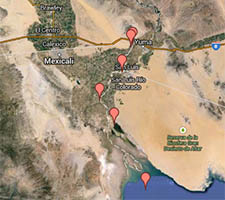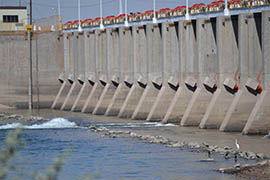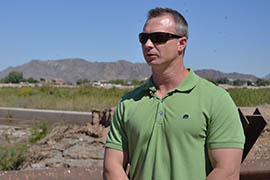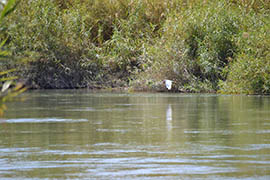Cronkite News has moved to a new home at cronkitenews.azpbs.org. Use this site to search archives from 2011 to May 2015. You can search the new site for current stories.
Officials in Mexico, U.S. collaborate on flood to boost Colorado River’s delta
YUMA – For more than 20 years, water from the Colorado River has stopped at Morelos Dam, which diverted its flow into Mexican canals for agriculture and municipal use. But in March, water began rushing through the gates to help regenerate the river’s delta habitats.
The experiment was the result of an agreement that allows Mexico to store water in U.S. reservoirs on the condition that some of its Colorado River allotment – 1.5 million acre feet yearly – be saved and used to stimulate the environment. Making it happen were government officials, scientists and activists on both sides of the border concerned about a once-thriving delta that’s been starved of water.
“We have lost almost 90 percent of the wetlands on the Mexican side in the delta,” said Francisco Zamora Arroyo, Colorado River Delta Legacy Program director at the Sonoran Institute.
In some areas of the delta, where what remains of the Colorado’s flow reaches the Gulf of California, nearly all cottonwood and willow forest has been lost, Arroyo said.
The loss of mature trees not only harms the nearly 400 species of birds in the area but also wildlife across North America.
Karl Flessa, a geoscientist at the University of Arizona, notes that the delta is on what’s known as the Pacific Flyway, serving as a critical pit stop for birds migrating as far north as Canada.
“If you’re a duck hunter in North Dakota you should care about the Colorado River delta because how good the environment is there determines to some extent how many ducks you’re going to be able to hunt in North Dakota,” Flessa said.
“When you bring back those trees, you’re also going to increase the habitat that’s available for birds, the birds that live there all year round as well as all the migratory birds that come through the delta twice a year,” he said.
In an attempt to regenerate the trees, a so-called pulse flow— delivering 105,392 acre feet of water over two months – was designed to wet the ground so fallen seeds from cottonwoods and willows can take root. The water initially flowed into the Colorado’s channel from Morelos Dam and later through spillways out of canals in Mexico, a process scheduled to continue through May 18.
“It’s a pulse flow in the sense that it’s a large volume of water in a short period of time that’s intended to, in a way, mimic a spring flood that we may have seen in the past,” said Aaron Marshall, water resources specialist at the Bureau of Reclamation’s Yuma office.
Despite the multi-agency planning that has gone into the experiment, the pulse flow has many uncertainties in terms of the hydrological and biological benefits, Marshall said. The timing of seed release from the cottonwoods and willow trees is critical and has to be calculated when trying to flood the banks.
In addition to the pulse flow, Arroyo said the Sonoran Institute has collected and prepared seeds to boost the chances of success.
“The natural availability of seeds is limited because there are not that many trees, so we collect the seeds from existing trees and then in the areas that got inundated and has the right conditions we will be applying seeds,” Arroyo said.
And while determining if this experimental program succeeds will take a number of years, Arroyo said in mid-April that he was already seeing trees begin to germinate.
“They are really small. They are not even half an inch, but you can see even after only four weeks germination of trees,” he said.
Flessa, who has studied the delta and the environmental effects of water diversions with his UA students for more than two decades, said the problems in the delta are a matter of overuse rather than undersupply.
“The current state of the delta is a consequence of the fact that the treaty allocations of water between the U.S. and Mexico results in the U.S. retaining approximately 90 percent of the river’s flow,” Flessa said.
“In both the U.S. and Mexico after we use it for cities and agriculture there’s none left for nature,” he said.
Although the direct impact of restoration efforts are more obvious south of the border, Doug Hendrix, external coordinator group manager at the Bureau of Reclamation’s Yuma office, said it still benefits the U.S.
“A healthy delta area is vital to both countries,” he said.












